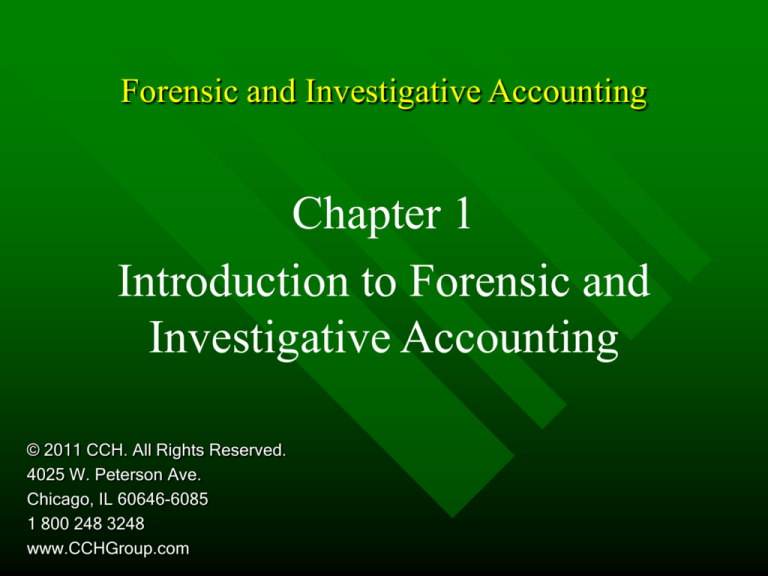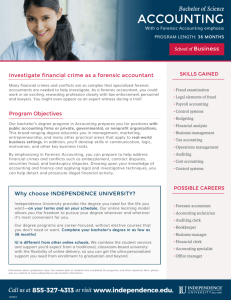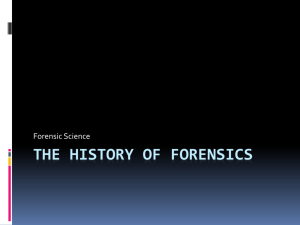
Forensic and Investigative Accounting
Chapter 1
Introduction to Forensic and
Investigative Accounting
© 2011 CCH. All Rights Reserved.
4025 W. Peterson Ave.
Chicago, IL 60646-6085
1 800 248 3248
www.CCHGroup.com
Forensic Accounting vs. Fraud Auditing
Fraud Auditor: An accountant especially
skilled in auditing who is generally engaged
in auditing with a view toward fraud
discovery, documentation, and prevention.
Chapter 1
Forensic and Investigative Accounting
2
Forensic Accounting vs. Fraud Auditing
Forensic Accountant: A forensic accountant
may take on fraud auditing engagements and
may be a fraud auditor, but he or she will also
use other accounting, consulting, and legal
skills in broader engagements. In addition to
accounting skills, he or she will need a
working knowledge of the legal system and
excellent communication skills to carry out
expert testimony in the courtroom and to aid
in other litigation support engagements.
Chapter 1
Forensic and Investigative Accounting
3
Forensic Accounting Defined
Time: Forensic accounting focuses on the past,
although it may do so in order to look forward.
Purpose: Forensic accounting is performed for a
specific legal forum or in anticipation of
presentation before a legal forum.
Peremptory: Forensic accountants may be
employed in a wide variety of risk management
engagements within business enterprise as a
matter of right, without the necessity of allegations
(e.g., proactive).
Chapter 1
Forensic and Investigative Accounting
4
Forensic Accounting Defined
Forensic accounting is the action of
identifying, recording, settling, extracting,
sorting, reporting, and verifying past financial
data or other accounting activities for settling
current or prospective legal disputes or using
such past financial data for projecting future
financial data to settle legal disputes.
Chapter 1
Forensic and Investigative Accounting
5
Historical Roots of Accounting
10,000 years ago—Temple priests took inventory of
village livestock.
3,000 B.C.—Scribes recorded ruler’s wealth.
1887—American Association of Public Accountants
(later becoming the AICPA) was formed.
1896—New York State legislated the first CPA law.
1900—School of Commerce, Accounts, and Finance
at New York University opens.
(continued on next slide)
Chapter 1
Forensic and Investigative Accounting
6
Historical Roots of Accounting
1902—Congress calls for audit reports for large
corporations.
1913—Federal Reserve Board created.
1913—Federal income tax law was passed.
1914—Federal Trade Commission created.
By 1921—All states had passed laws requiring exam
for CPA certificate.
Chapter 1
Forensic and Investigative Accounting
7
History of Financial Reports and
Legal Challenges
Financial reports were created by accountants
long before independent audits were mandated.
Current system of accounting checks and
balances is relatively recent.
(continued on next slide)
Chapter 1
Forensic and Investigative Accounting
8
History of Financial Reports and
Legal Challenges
Before financials were audited by outside
experts, the courts often handled challenges
and brought in experts to give testimony.
Practice of forensic accounting was common
even before independent accountants were
asked to certify financial statements in auditing
engagements.
Chapter 1
Forensic and Investigative Accounting
9
Threads of Forensic Accounting
1817—Canadian court decision of Meyer v.
Sefton.
1824—James McClelland started his business
in Glasgow, Scotland.
1856—In England, the audit of corporations
became required.
Chapter 1
Forensic and Investigative Accounting
10
Forensic Accounting in Print
Articles on arbitration, fraud, investigation, and
expert witnesses began appearing in the late
1800s.
After a comment in 1925 by the Chairman of
the U.S. Board of Tax Appeal, The Journal of
Accountancy proposed that educational
institutions should start including in their
curricula the study of the law of evidence.
Chapter 1
Forensic and Investigative Accounting
11
Phrase “Forensic Accounting” Is Born
Maurice E. Peloubet coined the phrase in print in 1946.
Max Lourie wrote an article and also claimed to coin the
phrase, seven years after Peloubet. Lourie’s article voiced
three important positions:
– An accountant should not have to attend law school to
learn the art of expert testimony.
– Colleges and universities should deliver forensic
accounting training.
– Forensic accounting reference books and textbooks
should be developed for students.
The first forensic accounting book appeared in 1982.
Chapter 1
Forensic and Investigative Accounting
12
FBI and Forensics
During WWII, the FBI employed
approximately 500 agents who were
accountants.
In 1960, about 700 FBI agents were Special
Agent Accountants.
Today, there are more than 600 FBI agents with
accounting backgrounds. The FBI has a
Financial Crimes Section that investigates
money laundering, Internet crimes, financial
institutions fraud, and any other economic
crime.
Chapter 1
Forensic and Investigative Accounting
13
AICPA Practice Aid
In 1986, the AICPA broke forensic accounting into
two broad areas: investigative accounting and
litigation support.
The types of litigation services were further broken
down in Practice Aid 7, listing:
– damages
– antitrust analyses
– accounting
– valuation
– general consulting
– analyses
Chapter 1
Forensic and Investigative Accounting
14
Panel on Audit Effectiveness
In 1998, the Public Oversight Board
appointed the Panel on Audit Effectiveness to
review and evaluate how independent audits
of the financial statements of public
companies are performed and to assess
whether recent trends in audit practices serve
the public interest.
Chapter 1
Forensic and Investigative Accounting
15
Panel on Audit Effectiveness
In 2000, the Panel issues a 200-page report,
Report and Recommendations, which includes
a recommendation that auditors should
perform forensic-type procedures during
every audit to enhance the prospects of
detecting material financial statement fraud.
Chapter 1
Forensic and Investigative Accounting
16
AICPA Fraud Task Force Report
In 2003, the AICPA’s Litigation and Dispute
Resolution Services Subcommittee issued a
report of its Fraud Task Force entitled,
“Incorporating Forensic Procedures in an Audit
Environment.”
The report covers the professional standards that
apply when forensic procedures are employed in
an audit and explains the various means of
gathering evidence through the use of forensic
procedures and investigative techniques.
Chapter 1
Forensic and Investigative Accounting
17
Accountant’s Role in Fraud Detection
In the early 1980s, companies began to use
computers to perform their record keeping.
Intense competition caused auditing fees to fall as
much as 50% from the mid-1980s to the mid1990s.
Auditors cut costs by reducing the process of
reviewing hundreds of corporate accounts. They
grew more reliant on internal controls.
The Journal of Forensic Accounting was created.
(continued on next slide)
Chapter 1
Forensic and Investigative Accounting
18
Accountant’s Role in Fraud Detection
Top executives were able to circumvent internal
controls and manipulate the records.
This lead to situations such as Enron, WorldCom,
Xerox, Adelphia Communication, and the fall of
Arthur Andersen in the early 2000s.
Due to the financial disaster of companies such as
Enron and WorldCom, there has been an increased
use of forensic techniques in audits and an increase
in fees.
(continued on next slide)
Chapter 1
Forensic and Investigative Accounting
19
Accountant’s Role in Fraud Detection
Some accounting experts believe that every audit
engagement should include much more skepticism
and detailed review of transactions.
Other accounting experts suggest that only special
engagements specifically targeting fraud can
adequately and effectively root out the problem.
The Big Four and the next two accounting firms
believe that every public corporation should have
a forensic audit every three years.
Chapter 1
Forensic and Investigative Accounting
20
Recent Events
Economic recessions often increase fraud, since executives may engage in more
“cooking the books” techniques to improve financial results, and financially
strapped employees will steal business funds or commit other types of fraud and
abuse. In April 2009, Audit Analytics predicted that 3,589 companies (nearly 25%)
will report that their auditors doubt they will continue as going concerns. In 2001,
the percentage was only 19.2 percent.1
The Federal Government’s $787 billion economic stimulus and bailout programs
will be breeding grounds for fraud, waste, and abuse. Dan Weil estimates that up
to $50 billion of the total (or 5 to 10 percent) will be susceptible to fraud. FBI
Director Robert Mueller warns of fraud stemming from the stimulus packages.2
There should be much work for forensic accountants.
Sarah Johnson, “Auditors: Nearly 25% of Companies May Not Be Going Concerns,” CFO, April 22,
2009, www.cfo.com/article.cfm/13525910/c_2984368/?f=archives
2 Dan Weil, “Expert: Stimulus Fraud May Hit $50 Billion,” Newsmax.com, June 16, 2009,
http://mmoneynews.newsmax.com/printTemplate.html
1
Chapter 1
Forensic and Investigative Accounting
21
Big-Six's Position
A forensic audit is akin to a police investigation.
All public companies should have a forensic audit on a regular
basis. Companies would be required to have such an audit
every three or five years or face these audits on a random
basis.
Forensic auditors scrutinize any records of companies,
including emails, and would be able, if not required, to
question all company employees, and to require statements
under oath.
Might be necessary for an audit network or a specialized
forensic auditors to complete a forensic audit with the aid of
independent attorneys (not those who have represented the
audit client in the other engagements).
Source: “Serving Global Markets and the Global Economy: A View from the CEOs of the
International Audit Networks, November 2006, p. 13.
Chapter 1
Forensic and Investigative Accounting
22
More Differences
Two practitioners have suggested these additional procedures may
be used in a forensic audit:
Extensive use of interviews and leveraging techniques
designed to elicit sufficient information to prove or
disprove a hypothesis.
Document inspection that may extend to authentication
procedures and handwriting analysis.
Significant public records search to uncover, for example,
unexpected title or ownership, other known addresses,
and prior records of individuals.
Legal knowledge regarding rules of evidence including
chain of custody and preservation of evidence integrity.
Source: Annett Stalker and M.G. Ueltzen, “An Audit Versus A Fraud Examination,” CPA Expert,
Winter 2009, p. 4.
Chapter 1
Forensic and Investigative Accounting
23
Inexperienced Forensic Auditors
Find out who did it. Do not worry about all the
endless details.
Be creative, think like the fraudster, and do not be
predictable. Lower the auditing threshold without
notice.
Take into consideration that fraud often involves
conspiracy.
Internal control lapses often occur during
vacations, sick outages, days off, and rest breaks,
especially when temporary personnel replace
normal employees.
H. R. Davia, Fraud 101, New York: John Wiley & Sons, 2000, pp. 42-45.
Chapter 1
Forensic and Investigative Accounting
24
Contrasting Auditing, Forensic
Accounting, and Fraud Examination
Characteristic
Audit
Fraud Examination
Forensic Accounting
Time perspective:
Historical
Historical
Future and historical
Primary focus:
Periodic
Reactive
Proactive and ongoing
Investigation scope:
Narrow
Narrow
Broad ranging
Main work product is:
Audit opinion
Fraud case report
Forensic audit report
Main responsibility to:
Company and
public
Defrauded party
Concerned principal or
third party
Guidelines are:
Rules-based
Principles-based; under audit Principles-based
rules, it is rule-based
Purpose of report:
Ensure GAAP
is followed
Identify perpetrator of fraud
Fraud risk assessment and
strategic services
Professional stance:
Nonadversarial
Adversarial
Adversarial and nonadversarial
Chapter 1
Forensic and Investigative Accounting
25
Some White Collar Crimes
Antitrust.
Bankruptcy fraud.
Corporate/securities fraud.
Health care fraud.
Insurance fraud.
Mass marketing fraud.
Money laundering.
Mortgage fraud.
Chapter 1
Forensic and Investigative Accounting
26
Sarbanes–Oxley Legislation
1.
2.
3.
4.
5.
6.
Title 1 establishes the Public Company Accounting Oversight Board
(PCAOB) under the SEC to regulate auditing and to discipline auditors.
Title 2 contains a series of rules to ensure that auditors are independent
from their clients. For example, neither the primary nor reviewing
partner may audit the same client for more than five consecutive years,
and the auditor must report all material written communication to the
audit committee.
Title 3 requires publicly traded companies to have an audit committee,
the CEO and CFO must certify their company’s financial statements,
and provides rules for the conduct of officers and their attorneys.
Title 4 prohibits personal loans and requires certain financial
disclosures.
Title 5 mandates rules for financial security analysts (i.e., research
analysts) to avoid conflicts of interest.
Titles 6, among other provisions, allows federal courts the power to bar
individuals who violate security laws from participating in penny
stocks.
Chapter 1
Forensic and Investigative Accounting
27
Sarbanes–Oxley Legislation
7.
8.
9.
10.
11.
Title 7 requires reports and studies on consolidation of accounting
firms, credit rating agencies, enforcement actions, and investment
banks.
Title 8 provides protection for whistleblowers and mandates penalties
and fines for certain acts not dischargeable by bankruptcy. For example,
failure of an auditor to keep working papers for 5 years is subject to
fines and 10 years in prison, and fine or imprisonment of up to 25 years
for anyone knowingly defrauding shareholders of publicly traded
companies. A person can receive 20 years in prison and fines for
altering, destroying, mutilating, concealing, covering up, falsifying or
making a false entry in any record, document, or tangible object.
Title 9 increases maximum prison sentences for mail and wire fraud
from 5 to 20 years. Willfully and knowingly certifying financial reports
not in compliance with the Act is now a criminal offense.
Title 10 says that it is the “Sense of the Senate” to require the CEO to
sign the corporate tax return.
Title 11 provides a possible 20-year prison sentence for anyone altering,
destroying, mutilating, or concealing a record, document, or other
object (or otherwise impeding) for an official proceeding.
Chapter 1
Forensic and Investigative Accounting
28






